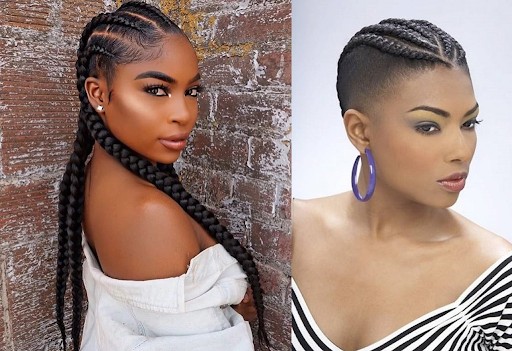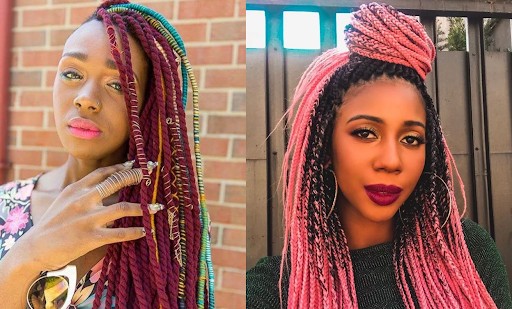
6 Popular Braiding Styles and Their True Origin
New trends of hairstyles emerge in the ever-changing world of beauty every day. Catching up on all of the many style trends is hard, but one thing is sure: braids have been a classic hairstyle forever, precisely since 3500 BC.
To put it another way, they go back. It’s reasonable to assume that the style has a long history and will continue to do so. This symbolic style has been a statement of socioeconomic rank, ethnicity, religion, and more, ranging from basic cornrows and simple three-strand braiding hair to box braids.
Braids have changed throughout time, thanks to Instagram, YouTube tutorials, TikTok trends, runways, and famous music festivals. Here you will learn about their origins, evolution, and six everyday braid hairstyles to try.
Continue reading for a fascinating history lesson that you’ll want to pay attention to. It’s a source of inspiration for ladies who braids hair and a resource for those with long, short, shoulder-length, or straight hair.
The Origin

An asset for the African tribes
Braiding was first practiced by the Himba people of Namibia in Africa. For ages, these people have braided their hair. Braided hairstyles were a unique method for many African tribes to distinguish themselves.
Hairstyles and braid patterns revealed a person’s tribe, age, marital position, wealth possession, authority, and religion. Braiding was and continues to be a communal activity. People frequently take the time to socialize because of the amount of time it takes. The elders braided their children’s hair, and the children would observe and learn from them.
The youngsters would begin practicing on one another and ultimately pick up on the established methods of the elders. This bonding custom was passed down through the generations and soon spread throughout the globe. Braids became quite fashionable in the early 1900s all over the world. Almost all women, children, and most men had their hair braided as a fashion statement.
The Evolution

The evolution of braids
Braiding patterns have remained consistent despite changes in expression and style. Braids are decorated, worn, and appreciated in a variety of ways in today’s society. People who previously would not have worn them are now embracing them.
Women in a variety of methods approach braiding. From fine lines to organic and chaotic braids, there’s something for everyone. Women are adopting a new attitude with these styles. We see messier and freer braid styles in today’s culture, which don’t have to be flawless. Braids are seen as a less perfect, stylish, and casual appearance.
Braids are more than simply a fashion statement; they’re a kind of art. Daily, women, and men of all ages get their hair braided. The skill of hair braiding has developed beyond the original cultural ideals; whether it’s a day when you just want your hair out of your face or a big formal event, it looks great on both occasions.
Braids are the go-to style for African-American ladies with natural textures. Not simply for fashion, this technique is utilized for kinkier textures as a type of protective styling. Braids protect natural hair from heat and humidity.
6 popular braiding styles
The Cornrows
Anyone can tell you that cornrows originated in Africa, but many people don’t seem to understand why. For the most part, elaborate hair braiding signified which tribe you belonged to. Cornrows on women stretch back to at least 3000 B.C., whereas cornrows on males date back to the eighteenth century, especially in Ethiopia. Braided hairstyles were used to identify warriors and rulers.
Cornrows, which are still widely worn in West Africa, can indicate one’s age, religious views, kinship, marital status, wealth and were also used as a form of self-expression. Men and women even accessorize their braids to style their cornrows and reflect their individuality.
The Ghana Braids/Banana Braids
The origins of Ghana braids, also known as banana braids, may be traced back to Africa. Ghana braids first occur in hieroglyphics and sculptures carved around 500 BC, demonstrating the importance Africans placed on their hair.
They’ve been a part of many distinct Ghanaian ethnic, religious, social, and cultural traditions for decades.
The start and end are what distinguish Ghana braiding from conventional cornrowing. Each braid begins tiny, soft, and natural, gradually becoming thicker and fuller in the center before tapering off at the ends.
The Fulani Braids
The Fula, also known as the Fulani Tribe, is the world’s most prominent nomadic pastoral tribe, occupying West Africa and the Sahel region.
Long hair is braided into five long braids that hang or are looped on the sides, with a hairstyle in the center of the head, in a highly classic hairstyle for ladies. Beads and cowrie shells are used to embellish the hair. Attaching the family’s silver coins and amber to braids as a historical sign and aesthetic purposes is a practice handed down through the centuries to mothers and young girls.
The Goddess Braids
It may be traced all the way back to Ancient Africa. The braids are generally significantly thicker throughout, elevated, smooth, and defined, and have a comparable form to classic cornrows. They represented artwork, originality, accuracy, and a new level of fashion.
The Box Braids
The box braids we all know and love today aren’t that different from the styles that women of Africa from over 3,000 years ago adorned. The box braids are a new fashion statement to this day. Women with different hair textures prefer this style because of its beauty and elegance.
In terms of time, material, and installation, box braids were costly. A woman who could sit for hours decorating her crown may have been believed to be a lady of riches. Installing them takes accuracy and care, and the procedure can take anywhere from four to eight hours.
Dread Braids and Faux Locs
Dreadlocks, which are generally linked with Rastafarians and Jamaicans, are African in origin. Bob Marley made this style famous.
Locs were also worn by ancient Egyptian pharaohs, as shown by tomb sculptures, paintings, and other artifacts. Mummified bodies with their locs still intact have been discovered thousands of years later.
3 braiding Ideas for Modern Women
Women have worn braids for thousands of years; throughout the world, the style is one of the most versatile, with designs ranging from simple to elaborate patterns. Braids are also appropriate for nearly any situation.
There’s a braided hairstyle for any occasion, including the office, school, the gym, and even a wedding. Braids can also preserve your strands from breakage and help you grow your mane longer, depending on your hair type. Different braided hairstyles for ladies are shown here.
-
Braided Ponytail

Braided ponytails
A high ponytail is the easiest method to style your braids if you’re searching for a different appearance. Because it makes your face appear longer, it’s also adaptable and suitable for both formal and informal situations. Secure your braided ponytail with a transparent snag-free elastic and wrap some of your braids around it to cover it to make it appear finished. Finally, add hair accessories for a pop of color.
Crochet Braids

Crochet braids
Crochet is one of the simplest and most straightforward methods for creating extra-long braids. Crochet, like a weave, starts with loose cornrows braided into your hair. You may use ready-made braids, such as box braids, which significantly reduce the time it takes to put your braids in. If you don’t have an additional day to spend in the stylist’s chair, this is a practical (DIY) Do It Yourself choice.
Yarn Braids

The colorful yarn braids
They are a sort of acrylic (non-wool fabric) extension. It is an excellent protective style for Afro-textured hair, especially in the cooler months of the year. Yarn braids are particularly striking because the material comes in a spectrum of hues; pastel pink, teal, and color-pop tones like vivid maroon and red are popular. Yarn braids are a flexible style option that works with all hair lengths.
Everything began in Africa. In fact, near the Nile River, the oldest known image of braiding was uncovered. Braids were even carved onto the rear of Giza’s Great Sphinx’s skull. African tribes, groups, and regions used headdresses for cultural reasons, and the fashions were as intricate and varied as the numerous types we know and love to replicate today.
Hair has historically been a marker of one’s social standing, money, religion, age, marital status, and position, much like fashion in history.
You’ll learn about the six most common braiding techniques today, as well as their origins. Black Friday Sale is coming soon, you can buy different types of braiding hair extensions to try this year.



